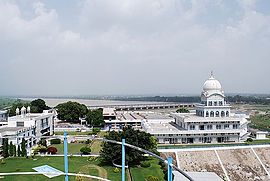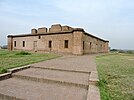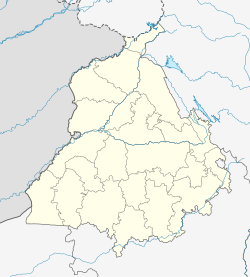Rupnagar
This article needs additional citations for verification. (June 2022) |
Rupnagar | |
|---|---|
City | |
Gurudwara Tibbi Sahib situated on the banks of Satluj (Rupnagar), Indus Valley Civilization (Rupnagar), Gurudwara Bhatha Sahib, Maharaja Ranjit Singh Park, Ropar Wetland, Satluj River Bridge. | |
| Nickname: Ropar | |
| Coordinates: 30°57′59″N 76°31′59″E / 30.9664°N 76.5331°E | |
| Country | |
| State | Punjab |
| District | Rupnagar |
| Established | 19th century (2000 BCE) |
| Government | |
| • Type | Municipal council |
| • Body | Ropar MC |
| Area | |
• Total | 13.65 km2 (5.27 sq mi) |
| Elevation | 262 m (860 ft) |
| Population (2011) | |
• Total | 56,000 |
| • Density | 4,100/km2 (11,000/sq mi) |
| Languages | |
| • Official | Punjabi |
| Time zone | UTC+5:30 (IST) |
| PIN | 140 001 |
| Telephone code | 91-1881 |
| Vehicle registration | PB-12 |
| Website | rupnagar |
Rupnagar[1][2] (/ˈrʊpnəɡər/; formerly known as Ropar) is a city and a municipal council in Rupnagar district in the Indian state of Punjab. Rupnagar is a newly created fifth Divisional Headquarters of Punjab comprising Rupnagar, Mohali, and its adjoining districts. It is also one of the bigger sites belonging to the Indus Valley civilization. Rupnagar is nearly 43 km (27 mi) to the northwest of Chandigarh (the nearest airport and the capital of Punjab). It is bordered by Himachal Pradesh to the north and Shahid Bhagat Singh Nagar district to its west.[3]
There are many historical and religious places in Rupnagar, including gurdwaras such as Gurudwara Bhatha Sahib, Gurdwara Bhubour Sahib, Gurdwara Solkhian and Gurudwara Tibbi Sahib.[citation needed]
History
[edit]Etymology
[edit]The ancient town of Rupnagar is said to have been named by a Raja called Rokeshar, who ruled during the 11th century and named it after his son Rup Sen.[4]

Rupnagar is one of the Indus Valley sites along the Ghaggar-Hakra beds.[6] There is an Archaeological Museum[7] in the city which was opened in the year 1998 for general public. The museum exhibits the archaeological remains of excavated site in the city, the first Harappan site of Independent India.[8] These excavations reveal a cultural sequence from Harappan to medieval times. Some of the important exhibits include antiquities of Harappan times, gold coins of Chandragupta and copper and bronze implements.[8]
Historical Background
[edit]
Sardar Hari Singh, Rais of Sialba, conquered Ropar in 1763 and established his state there. His son Sardar Charat Singh made Ropar capital of the state.[9] Later in Maharaja Ranjit Singh's Cis-Sutlej invasions in the early 1800s, he established Jagirs in the area including Mianpur and others.[10] In 1831, Ropar was under a Sikh chieftain, Bhup Singh, who had pledged his allegiance to the East India Company. Ropar shot into prominence when it was chosen as the venue for the meeting between Maharaja Ranjit Singh of the Sikh Empire and Lord William Bentinck, the Governor-General appointed by the Company. News of the Ropar Meeting reached Bokhara.[11]
Geography
[edit]Rupnagar is located at 30°58′N 76°32′E / 30.97°N 76.53°E.[12] It has an average elevation of 260 metres (850 ft). The town lies on the bank of Satluj River and the Shivalik hill range spreads along the opposite bank of the river.
Climate
[edit]The climate of Rupnagar is characterized by general dryness (except in the south west monsoon season), a hot summer and a cold winter. The year may be divided into four seasons. The period from about middle of November to February is the cold season. This is followed by the summer season from March to about the end of June. The south-west monsoon season commences late in June and continues up to about middle of September. The period from mid September to the middle of November constitutes the post-monsoon or transition season. The temperature ranges from a minimum of 1 °C (34 °F) in winter to 47 °C (117 °F) in summer. May and June are generally the hottest months and December and January are the coldest months. Relative humidity is high, averaging about 70% during monsoon. The average annual rainfall in the district is 1030mm. About 78% of the annual rainfall is received during June through September.[13]
Rupnagar wetland
[edit]
The city has one of the three important wetlands of the Punjab State known as Rupnagar Wetland or Ropar Wetland.It was declared as a Ramsar site in 2002[14][15][16][17][18] This is a man-made freshwater wetland covering 1,365 hectares. Also called the Rupnagar Lake, the wetland developed consequent to the construction of a regulator on the Sutlej River.[19] The area has a large number of birds, mammals and vegetation. It has at least 9 mammalian, 154 bird, 35 fish, 9 arthropod, 11 rotifer and 10 protozoan species. This important ecological zone is located in the Shivalik foothills of the Lower Himalayas and was created in 1952 on the Sutlej River, in the Punjab state of India, by building a head regulator.[20][21][22] The total area of the wetland is 1,365 hectares (3,370 acres). The wetland is surrounded by Shivalik hills to the northwest and by plains to the south and southeast.
Transport
[edit]Rupnagar railway station falls in the Northern Railway zone of the Indian Railways. It is connected to Chandigarh by a single line railway track. It is also connected to Amritsar via Jalandhar, Ludhiana, Morinda, Una (HP) and Nangal Dam.
Road
[edit]Rupnagar city has a road network to surrounding village and towns in district as well as to major cities including Una, Baddi, Ludhiana, Jalandhar, Chandigarh and Delhi. Rupnagar is connected by the National Highway system to the following nearby cities, by the following highway routes:
 NH 205 that connects Chandigarh, Kurali to Kiratpur Sahib, Himachal Pradesh via Rupnagar[23]
NH 205 that connects Chandigarh, Kurali to Kiratpur Sahib, Himachal Pradesh via Rupnagar[23] NH 103A connects Hoshiarpur to Rupnagar.[24]
NH 103A connects Hoshiarpur to Rupnagar.[24] NH 344A links Rupnagar to Phagwara, Jalandhar via Nawanshahr, Balachaur and Banga via NH103A at Balachaur.
NH 344A links Rupnagar to Phagwara, Jalandhar via Nawanshahr, Balachaur and Banga via NH103A at Balachaur.
Demographics
[edit]As per 2011 India census,[25] Rupnagar had a population of 56,038. Males constitute 52.8% of the population and females 47.2%. Rupnagar has an average literacy rate of 82.19%, higher than the national average of 74.04%: male literacy is 87.50%, and female literacy is 76.42%.[26][27][28]
Companies
[edit]Education
[edit]
Schools
[edit]Rupnagar has public as well as private schools which are affiliated to either Central Board of Secondary Education (CBSE) or Punjab School Education Board (PSEB) or Indian Certificate of Secondary Education (ICSE) and follow the 10+2 plan of education.[29]
Higher education
[edit]Rupnagar houses the Indian Institute of Technology Ropar which is spread over 525 acres in the banks of Satulj,[30] the Institute of Engineering and Technology, Bhaddal,[31] and Government College, Ropar[32] (affiliated to Punjabi University, Patiala[33]).Ropar is an education hub for local villages. Colleges in Ropar offers great opportunities to students from nearby districts too.
Notable people
[edit]- Himanshi Khurana, Indian model
- Rattan Chand, Senior bureaucrat for the Government of India
- Manpreet Gony, Indian Cricketer
- Kanshi Ram, Indian politician[34][35]
- Surjit Bindrakhia, Punjabi singer[36][37]
- Rana K. P. Singh, Indian politician[38][39]
Villages
[edit]- Assarpur
- [Behrampur Bet]
- [Bela]
See also
[edit]- Indus Valley civilization
- List of Indus Valley Civilization sites
- List of inventions and discoveries of the Indus Valley Civilization
- Hydraulic engineering of the Indus Valley Civilization
- Bara, Punjab
- Gaggon
- Sihon Majra
References
[edit]- ^ "Ropar | India | Britannica". www.britannica.com. Retrieved 22 June 2022.
- ^ "Rupnagar | Districts Profile | NRI Affairs Department". nripunjab.gov.in. Retrieved 22 June 2022.
- ^ "Map of District | Rupnagar Web Portal | India". Retrieved 22 June 2022.
- ^ "rupnagar city etymology". Retrieved 22 June 2022.
- ^ "Indus civilization | History, Location, Map, Artifacts, Language, & Facts | Britannica". www.britannica.com. Retrieved 22 June 2022.
- ^ Kodwani, Sunny (11 September 2016). Harappan Towns and Cities: Indus Valley Civilization, Indian Historical Tales. CreateSpace Independent Publishing Platform. ISBN 978-1-5375-4228-7.
- ^ "Archeological Museum | Rupnagar Web Portal | India". Retrieved 22 June 2022.
- ^ a b "ASI Museum - Rupnagar". rupnagar.nic.in. Retrieved 12 July 2017.
- ^ "Districts of India- Socio-economic statistical data of Rupnagar District, Punjab". www.indiastatdistricts.com. Retrieved 22 June 2022.
- ^ Who's who in India, Containing Lives and Portraits of Ruling Chiefs, Notables, Titled Personages, and Other Eminent Indians. Newul Kishore Press. 1911.
- ^ Wolff, J. (1861). Travels and Adventures of Rev. Joseph Wolff. Saunders, Otley, & Co. p. 374-5.
- ^ Falling Rain Genomics, Inc - Rupnagar
- ^ "Climate and Rainfall - Rupnagar". rupnagar.nic.in. 22 June 2022. Retrieved 26 December 2017.
- ^ "RAMSAR Wetland Sites". www.wiienvis.nic.in. Retrieved 22 June 2022.
- ^ Komal; Khattar, J. I. S.; Singh, D. P.; Singh, Yadvinder (2021). "New records of desmids from Ropar wetland (a Ramsar Site) of Punjab, India". Plant Science Today. 8 (4): 1037–1048. doi:10.14719/pst.2021.8.4.1229. ISSN 2348-1900. S2CID 238645818.
- ^ "Ropar | Ramsar Sites Information Service". rsis.ramsar.org. Retrieved 22 June 2022.
- ^ Vinod Kumar (28 January 2020). "Three more Punjab wetlands get Ramsar site tag | Chandigarh News - Times of India". The Times of India. Retrieved 22 June 2022.
- ^ "Ropar Wetland". SANDRP. Retrieved 22 June 2022.
- ^ "Punjab Tourism". punjabtourism.gov.in. Retrieved 26 December 2017.
- ^ DKGitHv-DTAC.
- ^ Jain, Sharad K.; Agarwal, Pushpendra K.; Singh, Vijay P. (16 May 2007). Hydrology and Water Resources of India. Springer Science & Business Media. ISBN 978-1-4020-5180-7.
- ^ The Journal of Cytology and Genetics. Society of Cytologists and Geneticists, India. 1990.
- ^ "Relation: NH205 (3210477)". OpenStreetMap. Retrieved 22 June 2022.
- ^ "National Highway 103A (NH103A) Travel Guide - Roadnow". roadnow.in. Retrieved 22 June 2022.
- ^ "Census of India 2011: Data from the 2011 Census". rupnagar.nic.in. Census Commission of India. 22 June 2022. Archived from the original on 16 June 2004. Retrieved 1 November 2008.
- ^ "Rupnagar District Population Census 2011-2022, Punjab literacy sex ratio and density". www.census2011.co.in. Retrieved 22 June 2022.
- ^ Experts, Arihant (4 June 2019). Know Your State Punjab. Arihant Publications India limited. ISBN 978-93-131-6766-2.
- ^ Census of India, 2011: pt.1. Provisional population totals. Directorate of Census Operations, Punjab. 2011.
- ^ "Schools | Rupnagar Web Portal | India". Retrieved 22 June 2022.
- ^ "Indian Institute of Technology Ropar | भारतीय प्रौद्योगिकी संस्थान रोपड़". www.iitrpr.ac.in. Retrieved 22 June 2022.
- ^ "Home page - Best colleges in Chandigarh IETBhaddal". ietbhaddal.edu.in. Retrieved 22 June 2022.
- ^ "Govt College Ropar". www.govtcollegeropar.org. Retrieved 22 June 2022.
- ^ "Punjabi University, Patiala | Higher Education Institute | NAAC "A" Grade | Punjab". www.punjabiuniversity.ac.in. Retrieved 22 June 2022.
- ^ "How 'manyavar' Kanshiram stood up for a colleague and changed Indian politics". ThePrint. 9 October 2018. Retrieved 22 June 2022.
- ^ "Kanshi Ram – A Great Indian Politician and Social Reformer". www.beaninspirer.com. 15 October 2020. Retrieved 22 June 2022.
- ^ "Surjit Bindrakhia". Spotify. Retrieved 22 June 2022.
- ^ "PTC Punjabi- Live Gurbani | World's No.1 Punjabi Entertainment Channel". PTC Punjabi. 15 April 2020. Retrieved 22 June 2022.
- ^ "Know the new Punjab Vidhan Sabha speaker, Rana KP Singh". Hindustan Times. 27 March 2017. Retrieved 22 June 2022.
- ^ Service, Tribune News. "Indian Constitution is best, says Rana KP". Tribuneindia News Service. Retrieved 22 June 2022.
External links
[edit]- Chisholm, Hugh, ed. (1911). . Encyclopædia Britannica. Vol. 23 (11th ed.). Cambridge University Press. p. 855.
- Govt. Website on Rupnagar
- Rupnagar BSNL telephone directory search
- Archaeological Museum in Rupnagar (Archaeological Survey of India)
- Location of Ropar in IVC map
- [1]








